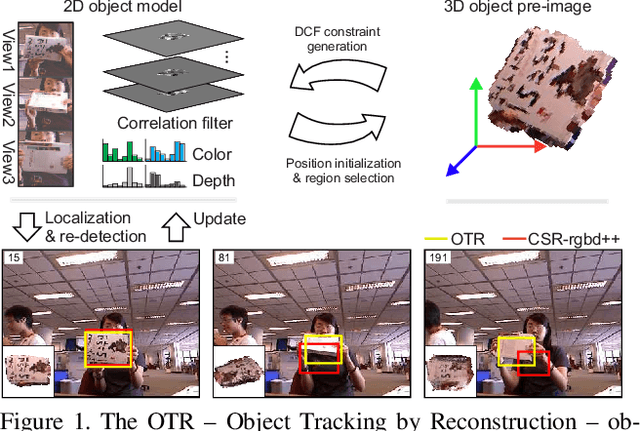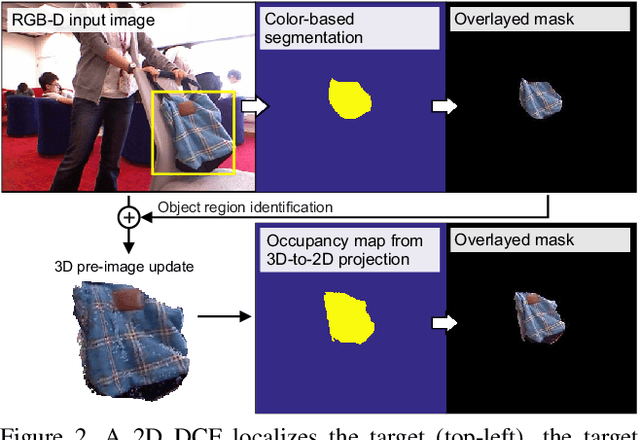Alan Lukezic
A Distractor-Aware Memory for Visual Object Tracking with SAM2
Nov 26, 2024Abstract:Memory-based trackers are video object segmentation methods that form the target model by concatenating recently tracked frames into a memory buffer and localize the target by attending the current image to the buffered frames. While already achieving top performance on many benchmarks, it was the recent release of SAM2 that placed memory-based trackers into focus of the visual object tracking community. Nevertheless, modern trackers still struggle in the presence of distractors. We argue that a more sophisticated memory model is required, and propose a new distractor-aware memory model for SAM2 and an introspection-based update strategy that jointly addresses the segmentation accuracy as well as tracking robustness. The resulting tracker is denoted as SAM2.1++. We also propose a new distractor-distilled DiDi dataset to study the distractor problem better. SAM2.1++ outperforms SAM2.1 and related SAM memory extensions on seven benchmarks and sets a solid new state-of-the-art on six of them.
A New Dataset and a Distractor-Aware Architecture for Transparent Object Tracking
Jan 08, 2024Abstract:Performance of modern trackers degrades substantially on transparent objects compared to opaque objects. This is largely due to two distinct reasons. Transparent objects are unique in that their appearance is directly affected by the background. Furthermore, transparent object scenes often contain many visually similar objects (distractors), which often lead to tracking failure. However, development of modern tracking architectures requires large training sets, which do not exist in transparent object tracking. We present two contributions addressing the aforementioned issues. We propose the first transparent object tracking training dataset Trans2k that consists of over 2k sequences with 104,343 images overall, annotated by bounding boxes and segmentation masks. Standard trackers trained on this dataset consistently improve by up to 16%. Our second contribution is a new distractor-aware transparent object tracker (DiTra) that treats localization accuracy and target identification as separate tasks and implements them by a novel architecture. DiTra sets a new state-of-the-art in transparent object tracking and generalizes well to opaque objects.
A Low-Shot Object Counting Network With Iterative Prototype Adaptation
Nov 15, 2022Abstract:We consider low-shot counting of arbitrary semantic categories in the image using only few annotated exemplars (few-shot) or no exemplars (no-shot). The standard few-shot pipeline follows extraction of appearance queries from exemplars and matching them with image features to infer the object counts. Existing methods extract queries by feature pooling, but neglect the shape information (e.g., size and aspect), which leads to a reduced object localization accuracy and count estimates. We propose a Low-shot Object Counting network with iterative prototype Adaptation (LOCA). Our main contribution is the new object prototype extraction module, which iteratively fuses the exemplar shape and appearance queries with image features. The module is easily adapted to zero-shot scenario, enabling LOCA to cover the entire spectrum of low-shot counting problems. LOCA outperforms all recent state-of-the-art methods on FSC147 benchmark by 20-30% in RMSE on one-shot and few-shot and achieves state-of-the-art on zero-shot scenarios, while demonstrating better generalization capabilities.
Trans2k: Unlocking the Power of Deep Models for Transparent Object Tracking
Oct 07, 2022



Abstract:Visual object tracking has focused predominantly on opaque objects, while transparent object tracking received very little attention. Motivated by the uniqueness of transparent objects in that their appearance is directly affected by the background, the first dedicated evaluation dataset has emerged recently. We contribute to this effort by proposing the first transparent object tracking training dataset Trans2k that consists of over 2k sequences with 104,343 images overall, annotated by bounding boxes and segmentation masks. Noting that transparent objects can be realistically rendered by modern renderers, we quantify domain-specific attributes and render the dataset containing visual attributes and tracking situations not covered in the existing object training datasets. We observe a consistent performance boost (up to 16%) across a diverse set of modern tracking architectures when trained using Trans2k, and show insights not previously possible due to the lack of appropriate training sets. The dataset and the rendering engine will be publicly released to unlock the power of modern learning-based trackers and foster new designs in transparent object tracking.
Object Tracking by Reconstruction with View-Specific Discriminative Correlation Filters
Nov 27, 2018



Abstract:Standard RGB-D trackers treat the target as an inherently 2D structure, which makes modelling appearance changes related even to simple out-of-plane rotation highly challenging. We address this limitation by proposing a novel long-term RGB-D tracker - Object Tracking by Reconstruction (OTR). The tracker performs online 3D target reconstruction to facilitate robust learning of a set of view-specific discriminative correlation filters (DCFs). The 3D reconstruction supports two performance-enhancing features: (i) generation of accurate spatial support for constrained DCF learning from its 2D projection and (ii) point cloud based estimation of 3D pose change for selection and storage of view-specific DCFs which are used to robustly localize the target after out-of-view rotation or heavy occlusion. Extensive evaluation of OTR on the challenging Princeton RGB-D tracking and STC Benchmarks shows it outperforms the state-of-the-art by a large margin.
 Add to Chrome
Add to Chrome Add to Firefox
Add to Firefox Add to Edge
Add to Edge